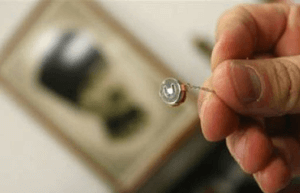TSCM stands for Technical Surveillance Countermeasures, a process known also known as electronic counter-surveillance, colloquially referred to as a “bug sweep”. Sweeping for bugs is one of the most technically advanced services that private investigators can offer, because it requires an array of expensive equipment along with trained experts who are aware of the proper techniques to use the equipment correctly.
While they may look simple in movies and on TV, bug sweeps are actually very difficult to perform. A trained expert must use a practiced methodology adapted to defeat the attacker’s technology and the attacker themselves, who may have taken steps to avoid detection.
must use a practiced methodology adapted to defeat the attacker’s technology and the attacker themselves, who may have taken steps to avoid detection.
Most common surveillance devices emit some sort of radio frequency to transmit data, so a TSCM expert will start by attempting to detect a radio signal. At its most basic level, using bug sweeping equipment is like tuning a radio. The bug is transmitting a radio signal containing the surveillance information being collected, be it video, audio or another kind of data. The operator must simply tune their bug sweeping device the the right frequency to catch the radio signal, just like tuning your car radio to catch the news.
This will only defeat the most basic of bugs however, because attackers may avoid detection using techniques like burst transmission or spread spectrum transmission. A burst transmission device collects information over a period of time, then sends it out all at once in a short burst, so the person sweeping for bugs won’t detect a signal unless they’re listening at exactly the right time. Spread spectrum transmission on the other hand, spreads the signal over a larger spectrum of radio frequency than a normal radio transmission, so that the signal is too quiet to be picked up unless the Technical Surveillance Countermeasures equipment is specially attuned to catch the correct spread spectrum transmission.
 Some surveillance equipment on the other hand doesn’t produce radio waves. These surveillance devices simply record information for later when the attacker has the opportunity to come back and collect the bug. To detect these devices the person sweeping for bugs can use a device that detects the magnetic fields given off by all computerized technology, or use thermal cameras to detect a heat signature. However, this may be impossible if the bug is in an office of another place filled with electronic devices because they magnetic fields and heat produced by other electronics will conceal the bug. In this case the bug often must be found through old fashioned physical searching.
Some surveillance equipment on the other hand doesn’t produce radio waves. These surveillance devices simply record information for later when the attacker has the opportunity to come back and collect the bug. To detect these devices the person sweeping for bugs can use a device that detects the magnetic fields given off by all computerized technology, or use thermal cameras to detect a heat signature. However, this may be impossible if the bug is in an office of another place filled with electronic devices because they magnetic fields and heat produced by other electronics will conceal the bug. In this case the bug often must be found through old fashioned physical searching.
These are a few of the most common kinds of bug sweep equipment:
As you can see, bug sweeping is a complicated process that requires not only huge number of gadgets, but also knowledge of how attackers operate, such as where they place their bugs and how they use them. So while it may have looked easy on that episode of Miami Vice, in reality, it’s best left to the professionals.